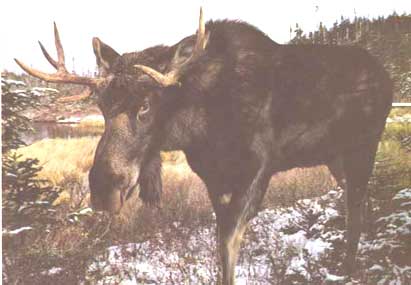EMail
CoastalSafari@
CoastalSafari.com
Telephone
1-877-888-3020 (Toll free) or
709-579-3977
Mailing Address

Bull Moose (Alces alces)c. W. Montevecchi
This ungainly mammal is the world's largest living deer. It is found
throughout most of the northern forests of Canada. It was not native to
Newfoundland but was introduced here on two different occasions. In 1878
a bull and a cow were brought from Nova Scotia and
released at Gander Bay. In 1904 two bulls and two cows from New Brunswick
were released near Howley. The story of how the New Brunswick moose were
captured is told by
John Nowlan of Chatham, New Brunswick
. By 1920 moose were being recorded in good numbers over fifty miles
from Howley. By 1935 moose occupied much of the island. In 1941 moose were
first reported from the Avalon Peninsula.
That a healthy population of animals has arisen from such a small original population raises some interesting questions about the concept of genetic bottlenecking.
While most active during the twilight and early dawn, moose may be
observed abroad at any time of the day or night. They are solitary animals.
However during the summer several moose may occupy the same pond or marsh
to feed on aquatic vegetation. They feed independently afterwards returning
to their solitary existence. Moose are good waders and swimmers. In addition
to aquatic vegetation, the summer diet also includes broad leaved trees,
shrubs and grasses. In winter balsam fir is a diet staple but bark peeled
from a number of other tree species as well. In areas of deep snow, favourable
feeding
areas may attract a number of moose together in a "yard".
The rut or breeding season begins about the middle of September and
may continue until late October. During the rut the bulls seek out the cows.
At this time the bulls are very aggressive and curious, investigating every
sound in the woods. After a gestation period of about 245 days a calf (rarely
more than one) weighing approximately 30 pounds is born in
late May or early June. The young moose remains with its mother throughout
the winter but is driven away just before the mother calves again in the
spring. At this time the yearling may weigh 400-500 pounds. The majority
of moose breed for the first time in the fall following their second birthday.
Two year old bulls compete for the cows but the older
bulls usually drive their younger competitors away. Not all the cows bear
young every year.
Antlers are shed during the winter, older animals losing their larger sets first. Early spring sees the new antlers beginning to grow, reaching full size in August. This large animal has a relatively small home range - the entire summer may be spent in a hundred acre area. During the rut the males range over a much larger area. In spring young moose occasionally wander into St. John's and have to be tranquillized and returned to the woods. A collision with a moose is a very real possibility for every driver on the roads of Newfoundland, especially at night.
References: Northcott, Tom H., The Land Mammals of Insular
Newfoundland. Wildlife Division, Dept of Tourism. Government of Newfoundland.
1974.
Canadian Wildlife Service, Hinterland Who's Who Series. 1968.
Bergerud, A.T. and F. Manuel. 1968. Moose damage to balsam fir - white
birch forests in central Newfoundland. Journal of Wildlife Management
42(4): 729-746.
![]()
